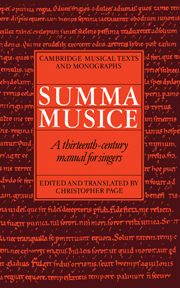Book contents
- Frontmatter
- Contents
- Preface
- Abbreviations
- Intervallic notation in the Summa musice
- 1 The authorship of the treatise
- 2 The scope and character of the treatise
- 3 Sources and metrics
- 4 The text and the edition
- Summa musice: The translation
- Summa musice: The text
- Textual notes and rejected readings
- Sources, parallels, citations and allusions
- Appendix
- Bibliography
- Annotated catalogue of chants
- Index auctorum
4 - The text and the edition
Published online by Cambridge University Press: 14 January 2010
- Frontmatter
- Contents
- Preface
- Abbreviations
- Intervallic notation in the Summa musice
- 1 The authorship of the treatise
- 2 The scope and character of the treatise
- 3 Sources and metrics
- 4 The text and the edition
- Summa musice: The translation
- Summa musice: The text
- Textual notes and rejected readings
- Sources, parallels, citations and allusions
- Appendix
- Bibliography
- Annotated catalogue of chants
- Index auctorum
Summary
The Summa musice as we have it incorporates several layers of interpolation. At some stage an interpolator lengthened the Metrum of Chapter XX, splitting it apart in three places and inserting verse mnemonics, cast in hexameters, of the kind to be found in many medieval manuscripts (especially German ones) and mostly concerned with modal finals, the modal classification of various antiphons and related matters. Gerbert printed the interpolated lines as if they were part of the Metrum, but passages such as these destroy the rhyme scheme and seem very unlikely to have been part of the original text:
Tertius est quinque quoniam Dominus Symeonem
Quartus post Rubum pete Beata fidelia Syon
Quintus Vox alma sextus notum Benedictus…
It is possible to demonstrate that these lines, and others like them, entered the text of the Summa musice some time after the second-layer chapter of c. 1225–37. At line 2123 the author of the second-layer chapter gives the total number of verses in the whole treatise as 860. The text edited here with the mnemonic hexameters deleted comprises 864 lines, and given the likelihood that the very last couplet is not to be included in the count (it is a kind of colophon, as noticed by the scribe who sets it well apart) then the total number of hexameters in this edition is 862, only two lines higher than the correct sum. Even with these deletions made the number of lines in the text is too high, so it is plain that interpolations have been made since the author of the second-layer chapter made his count.
- Type
- Chapter
- Information
- Summa MusiceA Thirteenth-Century Manual for Singers, pp. 41 - 44Publisher: Cambridge University PressPrint publication year: 1991



